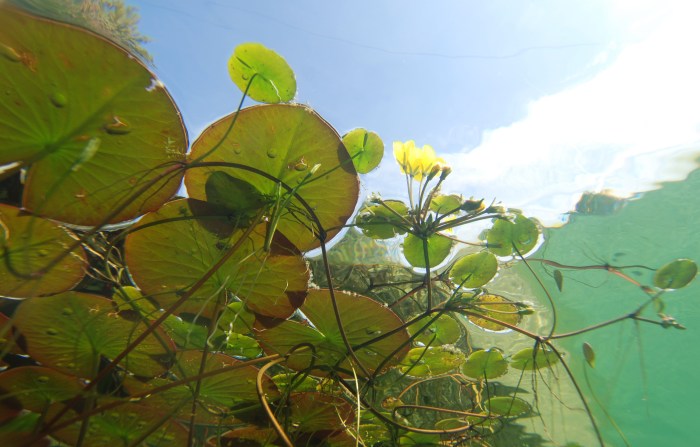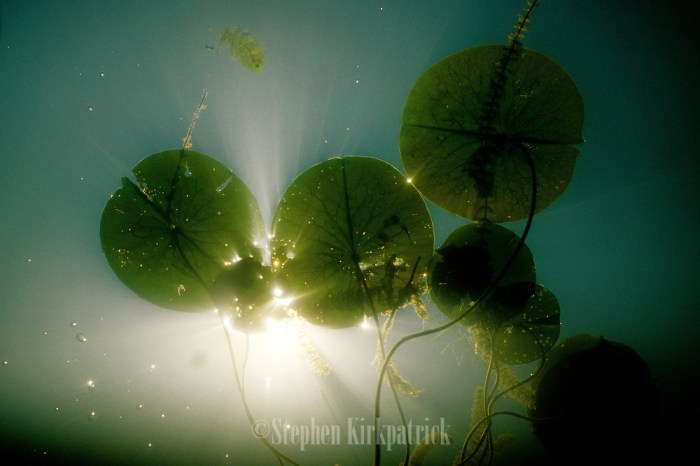Underneath a lily pad, a hidden world teeming with life and ecological significance awaits exploration. From the intricate adaptations of creatures that call it home to the cultural and historical tales woven around it, this verdant haven offers a captivating glimpse into the wonders of nature.
The lily pad, with its ample size, oval shape, and vibrant green hue, forms a protective canopy above, while the tranquil waters beneath provide a sanctuary for a diverse array of organisms.
Underneath a Lily Pad

Beneath the tranquil surface of a lily pad, a vibrant ecosystem unfolds. This verdant sanctuary teems with life, providing shelter, food, and breeding grounds for a myriad of creatures. Let us delve into the wonders that lie beneath the lily pad, exploring its intricate web of life and its profound ecological significance.
Description of the Scene
The lily pad, a floating leaf of the water lily plant, forms a protective canopy above the water. Its broad, oval shape can range in size from a few centimeters to over a meter in diameter. The upper surface is a deep, lustrous green, waxy to the touch and repelling water.
The underside, in contrast, is a paler green, with a network of veins that transport water and nutrients throughout the leaf.
The lily pad’s surroundings vary greatly. It may rest in the still waters of a pond or lake, surrounded by reeds and cattails. Alternatively, it may float in a flowing river, its edges gently swaying with the current. The water’s clarity and depth influence the light conditions beneath the lily pad, shaping the composition of the ecosystem.
Creatures and Organisms
Beneath the lily pad, a microcosm of life thrives. Tiny creatures, adapted to this unique environment, find refuge and sustenance within its protective embrace.
- Water fleas:These microscopic crustaceans are abundant beneath lily pads, feeding on algae and detritus. Their presence indicates a healthy ecosystem with ample food sources.
- Damselfly nymphs:The larvae of damselflies, with their slender bodies and large eyes, hunt for prey among the lily pad’s roots and submerged vegetation.
- Tadpoles:The young of frogs and toads spend their early lives beneath lily pads, protected from predators and finding ample food in the form of algae and microorganisms.
- Snails:Small freshwater snails graze on the lily pad’s surface, consuming algae and decaying plant matter.
- Mayfly nymphs:These aquatic insects spend their juvenile stage clinging to the underside of lily pads, feeding on algae and detritus.
Ecological Importance
The lily pad plays a crucial role in maintaining the health and biodiversity of its aquatic ecosystem.
- Shelter:The lily pad’s broad leaves provide shelter from predators for a variety of organisms, including small fish, insects, and amphibians.
- Food:The lily pad itself serves as a food source for herbivorous creatures such as snails and mayfly nymphs. Additionally, the algae and microorganisms that grow on the lily pad’s surface provide sustenance for many aquatic animals.
- Breeding grounds:The lily pad’s sheltered environment offers a safe haven for frogs and toads to lay their eggs and for young fish to develop.
- Water quality:The lily pad’s roots absorb excess nutrients from the water, helping to improve water quality and reduce the risk of algal blooms.
- Oxygen production:The lily pad’s leaves release oxygen through photosynthesis, contributing to the overall oxygen levels in the water.
Cultural and Historical Significance
The lily pad has been a source of inspiration and cultural significance for centuries.
- Art and literature:The lily pad’s graceful shape and vibrant colors have been depicted in paintings, drawings, and literary works throughout history.
- Myths and legends:In many cultures, lily pads are associated with myths and legends about water spirits and fairies.
- Traditional uses:Lily pads have been used in traditional medicine, as food, and as building materials in various cultures.
Conservation and Threats, Underneath a lily pad
While lily pads are resilient plants, they face several threats that could impact their populations and the ecosystems they support.
- Habitat loss:Destruction or degradation of aquatic habitats due to pollution, urbanization, and climate change can reduce the availability of lily pads.
- Chemical pollution:Pesticides and other chemicals can accumulate in lily pads, harming the organisms that rely on them.
- Invasive species:Non-native plants, such as water hyacinths, can outcompete lily pads for resources and space.
- Climate change:Rising temperatures and changes in precipitation patterns can affect the growth and distribution of lily pads.
Conserving lily pads is essential for maintaining healthy aquatic ecosystems and supporting the diverse creatures that rely on them. Conservation measures include protecting their habitats, reducing pollution, and managing invasive species.
General Inquiries: Underneath A Lily Pad
What is the significance of lily pads in the ecosystem?
Lily pads provide shelter, food, and breeding grounds for various aquatic organisms, contributing to biodiversity and ecosystem health.
What threats do lily pads face?
Pollution, habitat destruction, and invasive species pose significant threats to lily pads and their habitats.
How can we conserve lily pads?
Protecting water quality, restoring habitats, and controlling invasive species are crucial measures for conserving lily pads.


